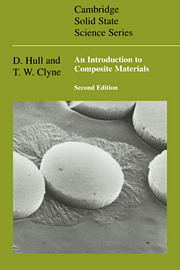Book contents
- Frontmatter
- Contents
- From the preface to First Edition
- Preface to Second Edition
- 1 General introduction
- 2 Fibres and matrices
- 3 Fibre architecture
- 4 Elastic deformation of long-fibre composites
- 5 Elastic deformation of laminates
- 6 Stresses and strains in short-fibre composites
- 7 The interface region
- 8 Strength of composites
- 9 Toughness of composites
- 10 Thermal behaviour of composites
- 11 Fabrication
- 12 Applications
- Appendix: Nomenclature
- Author index
- Subject index
From the preface to First Edition
Published online by Cambridge University Press: 05 June 2012
- Frontmatter
- Contents
- From the preface to First Edition
- Preface to Second Edition
- 1 General introduction
- 2 Fibres and matrices
- 3 Fibre architecture
- 4 Elastic deformation of long-fibre composites
- 5 Elastic deformation of laminates
- 6 Stresses and strains in short-fibre composites
- 7 The interface region
- 8 Strength of composites
- 9 Toughness of composites
- 10 Thermal behaviour of composites
- 11 Fabrication
- 12 Applications
- Appendix: Nomenclature
- Author index
- Subject index
Summary
A book on composite materials which is fully comprehensive would embrace large sections of materials science, metallurgy, polymer technology, fracture mechanics, applied mechanics, anisotropic elasticity theory, process engineering and materials engineering. It would have to cover almost all classes of structural materials from naturally occurring solids such as bone and wood to a wide range of new sophisticated engineering materials including metals, ceramics and polymers. Some attempts have been made to provide such an over-view of the subject and there is no doubt that the interaction between different disciplines and different approaches offers a fruitful means of improving our understanding of composite materials and developing new composite systems.
This book takes a rather narrower view of the subject since its main objective is to provide for students and researchers, scientists and engineers alike, a physical understanding of the properties of composite materials as a basis for the improvement of the properties, manufacturing processes and design of products made from these materials. This understanding has evolved from many disciplines and, with certain limitations, is common to all composite materials. Although the emphasis in the book is on the properties of the composite materials as a whole, a knowledge is required of the properties of the individual components: the fibre, the matrix and the interface between the fibre and the matrix.
The essence of composite materials technology is the ability to put strong stiff fibres in the right place, in the right orientation with the right volume fraction.
- Type
- Chapter
- Information
- An Introduction to Composite Materials , pp. xiii - xivPublisher: Cambridge University PressPrint publication year: 1996



